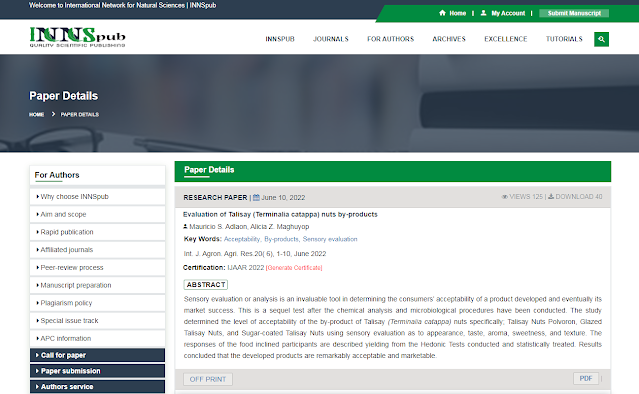.jpg) |
| Source: Wikipedia |
Author Name
Mauricio S. Adlaon and Alicia Z. Maghuyop
Institute: Surigao State College of Technology, Philippines
Journal Name
International Journal of Agronomy and Agricultural Research | IJAAR
Publisher Name
International Network For Natural Sciences | INNSpub
Abstract
Sensory evaluation or analysis is an invaluable tool in determining the consumers’ acceptability of a product developed and eventually its market success. This is a sequel test after the chemical analysis and microbiological procedures have been conducted. The study determined the level of acceptability of the by-product of Talisay (Terminalia catappa) nuts specifically; Talisay Nuts Polvoron, Glazed Talisay Nuts, and Sugar-coated Talisay Nuts using sensory evaluation as to appearance, taste, aroma, sweetness, and texture. The responses of the food inclined participants are described yielding from the Hedonic Tests conducted and statistically treated. Results concluded that the developed products are remarkably acceptable and marketable.
Introduction
The value of conducting sensory evaluation underscores the level of acceptability of a product developed prior to its extension or commercialization. Hence, Singh-Achbarali and Maharaj (2014) considered it as an invaluable tool in determining the consumers’ acceptability of a product and eventually its market success. It must be noted that characterization as to appearance, aroma, flavor, texture, and after-sensation of products cannot be accomplished or predicted by chemical or instrumental laboratory measurements.
According to Sidel & Stone (2004), sensory evaluation is a scientific discipline used to evoke, measure, analyze and interpret those responses to products as perceived through the senses of sight, smell, touch, taste, and hearing. Generally, grading methods for food and beverage products traditionally involved one or two trained “experts” assigning quality scores on the appearance, and flavor of the products based on the presence or absence of predetermined defects. Yang (2015) posited that sensory analysis help in grasping the characters of various food products. Thus, by using the traditional methods of evaluation, some products with different sensory characteristics, such as those identified by a product profile, but with no product defect will obtain the same quality score.
This is where sensory evaluation becomes an invaluable tool. In support, Singh-Achbarali and Maharaj (2014) contended that without sensory evaluation, development efforts reflect the personal feelings, views and choices of the product developer, product development team, marketer/s and/or top management and results that may be used to base product development trade-offs and decisions, product development successes will be few and development timelines very long. Watts (1989), also affirmed that there is no one instrument that can replicate or replace the human response making sensory evaluation component of any food study essential. Meiselman (1993), on the other hand, stressed the need for integration of sensory and hedonic dimensions rather than separation of these dimensions.
The current study is inclined to product development derived from Talisay nuts out from Talisay seeds as the trees grow abundantly in some areas in Surigao del Norte particularly in Malimono and nearby areas. Since only a few researchers have studied the possibility of developing a new product from the Talisay seeds and nut extracts, the researchers have unlocked its possibility through this study. As the by- products already underwent chemical analysis and microbiological procedures, the researchers would then determine the level of acceptability of the products through sensory evaluation or analysis reducing the subjectivity aspects in rating prior to its extension and or commercialization venture. Check out more by following the link Evaluation of Talisay (Terminalia catappa) nuts by-products
Reference
Dikilitaş K, Griffiths C. 2017. Thinking About the Context: Setting (Where?) and Participants (Who?). In: Developing Language Teacher Autonomy through Action Research. Palgrave Macmillan, Cham.
Lawless HT, Heymann H. 1998. Sensory Evaluation of Food Principles and Practices. New York: Chapman & Hall.
Meiselman HL, Macfie HJH. 1996. Food Choice Acceptance and Consumption, Glasglow, United Kingdom, Backie Academic & Professional.
Schiano AN, Harwood WS, Drake MA. 2017. A 100-Year Review: Sensory analysis of milk. Journal of Dairy Science 100(12), 9966-9986. https://doi.org/ 10.3168/jds.2017-13031
Singh-Ackbarali D, Maharaj R. 2014. Sensory Evaluation as a Tool in Determining Acceptability of Innovative Products Developed by Undergraduate Students in Food Science and Technology at the University of Trinidad and Tobago, Journal of Curriculum and Teaching 3, 1. https://doi.org /10.5430/jct.v3n1p10
Stone H, Sidel J. 2004. Introduction To Sensory Evaluation. In: Food Science Technology, Sensory Evaluation Practices (2nd ed.). https://doi.org /10.1016 /B978-012672690-9/50005-6
Watts BM, Jeffery IE, Elias LG. 1989. Basic Sensory Methods for Food Evaluation.Ottawa, Ontario (Canada): International Development Research Centre.
Yang Z. 2015. Research on the Sensory Design and Evaluation System for Food Shape and Color. Advance Journal of Food Science and Technology 8(12), 901-904. DOI:10.19026/ajfst.8.2728















0 comments:
Post a Comment